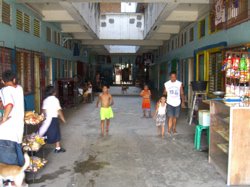The Story of Smokey Mountain

Smokey Mountain - named firstly as a mountain because it has been as high as 35 m and secondly because it smokes almost continuously during the hot summer months. Waste from the City of Manila was first dumped here almost 50 years ago. Before that it was actually a fishing village, the sea is now a kilometre or so away from Smokey. The land has been reclaimed with dumped garbage over the years.
Around 15 years ago if you went to Smokey Mountain you would have found around 4,000 families living on and around the active dumpsite. The families were mostly poor migrants who came to Manila from the provinces in search of work. Smokey was a good location because it was cheap to live on and its close proximity to the ports where itinerant work could be found. Contrary to popular belief, not all the families living there were scavengers. Of course, a large number of them did try and scrape together a living from pulling anything of any value out of the numerous trucks that dumped rubbish there every day.

Side view of the still present dumpsite, with accomodation in the background.
In 1993, Smokey Mountain was closed and the government made a promise to provide housing to the squatters and to rehabilitate the mountain (we’re still waiting for that last one). Around 3,000 families were housed in temporary accommodation nearby while the new permanent accommodation was constructed. The rest of the families were housed in other areas or accepted cash grants.

Another view of the Smokey Mountain Community
The temporary housing, which stretched from what was supposed to be 2 years to about 10 years, is a fairly squalid example of accommodation. From what I understand, the two storey structures were open inside and families were to construct their own walls to get privacy. There was only 1 bathroom per floor. I imagine that would have had to be shared by 50 families. The temporary housing is still there and a new bunch of squatters has moved in. Now, with no electricity or running water and no-one responsible for any repairs, it is quite a depressing area.
Around 2004, the families were moved into their new accommodation, the permanent housing. This is also sometimes referred to as Paradise Heights. Although I notice that tends to be by outsiders, the residents still refer to it as Smokey Mountain. It probably has something to do with the still smoking, still 25 odd metre high mountain of garbage never more than 100 m away from all the housing.
The new housing is 5 stories high, with 24 units on each floor. Someone said to me once the units are about 32 square metres. Each unit has its own bathroom with a toilet and shower head. The sleeping quarters are a mezzanine level about half the size of the bottom level. A lot of the residents have done renovations and extended their mezzanine to cover the whole area. They have electricity and water is available from 6 am - 8 am and 6 pm - 8 pm daily, which means water needs to be stored for toilet flushing, washing and cooking in big containers during the ‘off’ hours.

Inside one of the buildings (Building 26)
 'Smokey – Fashion for People' is a funky new label coming out of the back streets of Manila. Working together with emerging Australian fashion designers, the Smokey Mountain community is producing exciting poverty-busting urban designs with an ethical edge.
To view our garments, look under February 2006 archives.
For more information email us on smokeyfashion@gmail.com
'Smokey – Fashion for People' is a funky new label coming out of the back streets of Manila. Working together with emerging Australian fashion designers, the Smokey Mountain community is producing exciting poverty-busting urban designs with an ethical edge.
To view our garments, look under February 2006 archives.
For more information email us on smokeyfashion@gmail.com
2 Comments:
Mabuhay ka, Natalie!
wonderful!
Post a Comment
<< Home